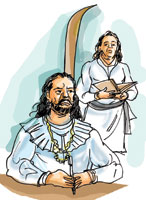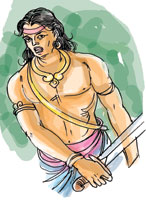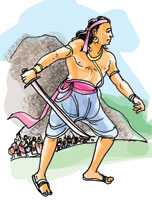King Don Juan Dharmapala took a
decision after listening
to the advice of the Franciscan monks. That was to name the King of Portugal as the claimant to the throne of Kotte, after the demise of the king, because the king had no son to succeed him. Accordingly, the last will was written on the 12th of August 1580 AD. By this time, King Mayadunne too had grown old and feeble.
He had entrusted the rule to Prince Tikiri Bandara. King Mayadunne had another son and a daughter by the
Chief-Queen. Tikiri Bandara was born to a dancing woman in the
palace. But the king’s choice was Prince Tikiri Bandara. As a raw youth, this prince had displayed his skills. He was quite clever in managing the affairs of the army. Because of this, he won the epithet – ‘Rajasinghe’. The prince seemed to like this name.
When he was just a young prince, the people thought that one day, this prince would definitely win fame and glory. The prince had succeeded in annexing to the Sitawaka Kingdom, a number of villages that belonged to the Raigam and Kotte Kingdoms. Once he became king, he wanted to be ‘Rajadhi-Rajasinghe of Sri Lanka’. He had hopes of conquering Kotte and Kandy too. With this in mind, he engaged in a number of battles with these kingdoms, during the rule of his father, but they were unsuccessful.
If he were to be the ruler of Kotte, Prince Rajasinghe, had to conquer Colombo. He got ready
for this task. He enrolled
a huge army by
recruiting men from areas that were under his rule. They were supplied with arms and given a training too. Once this was done, he marched to besiege the city of Colombo. This happened just a few days after the arrival of Manuel
Susa-Kutinna, as the Captain of Colombo. He had just assumed duties.
It was at an unexpected time.
The Portuguese in Colombo were not at all prepared to face this
situation and if the city was besieged, they could only fight. The walls of the city were short and they were not strong either. The
fortifications of the city had not been maintained properly and they
were in poor condition. There was a shortage of arms too. There were only about 500 Portuguese soldiers to guard the city. Muslims, Chetties and all other mercenary soldiers were about 600 in number.
The armies of Sitawaka, crossed the Kelani river using two makeshift bridges erected hurriedly for this purpose. They camped at a place called Boralugoda, which is modern Wolfendhal Street. Then they tried to pull down the security barrier in front named St. Thomas. But the Portuguese
somehow managed to foil their attempt. In those days, the Beira Lake,
was a tank, with a few
scattered islands.
This gave special natural
security to the city of Colombo.
King Rajasinghe tried to drain the water by cutting drains, but that was of no effect. Once again, he attacked the security barrier and
conquered the little islands. The Portuguese somehow managed to chase them away. However, the Sitawaka soldiers managed to gain entrance to the camp and rob many things. King Rajasinghe then got his men to cut a deep drain across the highland which was separated from the marshy areas near the Beira Lake.
This area was later named St. Bastian Hill. This drain was used to divert the water to the marshy area. This made it difficult for the security boats of the Portuguese to sail. This proved
to be an advantage for the Sinhala army. Once all this was completed, King Rajasinghe used all his forces and attacked the city of Colombo.
|




